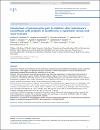Comparison of postoperative pain in children after maintenance anaesthesia with propofol or sevoflurane: a systematic review and meta-analysis.

View/
Publisher version (Check access options)
Check access options
Date
2024-04-26Author
Abdallah, Bushra MElshoeibi, Amgad M
ElTantawi, Nouran
Arif, Mariah
Hourani, Razan F
Akomolafe, Aishat F
Hamwi, Mahmoud N
Mahmood, Fathima R
Saracoglu, Kemal T
Saracoglu, Ayten
Chivese, Tawanda
...show more authors ...show less authors
Metadata
Show full item recordAbstract
Propofol and sevoflurane are two of the most commonly used anaesthetics for paediatric surgery. Data from some clinical trials suggest that postoperative pain incidence is lower when propofol is used for maintenance of anaesthesia compared with sevoflurane, although this is not clear. This meta-analysis compared postoperative pain following maintenance of anaesthesia with propofol or sevoflurane in paediatric surgeries. PubMed Medline, Embase, Scopus, Web of Science and Cochrane Library were searched for randomised controlled trials (RCTs) that compared postoperative pain between sevoflurane and propofol anaesthesia in children. After quality assessment, a meta-analysis was carried out using bias-adjusted inverse heterogeneity methods, heterogeneity using I and publication bias using Doi plots. In total, 13 RCTs with 1174 children were included. The overall synthesis suggested nearly two-fold higher odds of overall postoperative pain in the sevoflurane group compared with the propofol group (odds ratio [OR] 1.88, 95% confidence interval [CI] 1.12-3.15, I=58.2%). Further, children in the sevoflurane group had higher odds of having higher pain scores (OR 3.18, 95% CI 1.83-5.53, I=20.9%), and a 60% increase in the odds of requiring postoperative rescue analgesia compared with propofol (OR 1.60, 95% CI 0.89-2.88, I=58.2%). Children maintained on inhalational sevoflurane had higher odds of postoperative pain compared with those maintained on propofol. The results also suggest that sevoflurane is associated with higher odds of needing postoperative rescue analgesia compared with propofol. The protocol for this systematic review and meta-analysis was registered on the International Prospective Register of Systematic Reviews (PROSPERO) with registration ID CRD42023445913.
Collections
- Medicine Research [1932 items ]


